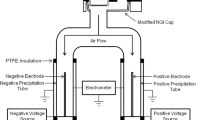Abstract
Purpose. To evaluate the dependence of fine particle dose charge (FPD charge) generated from powder inhalers on physico-chemical properties of the inhalation powder, inhaler type, deaggregation mechanism, dose number and/or retained powder.
Methods. Electrostatic charges were determined on micronized powders and aerosolized fine particle doses withdrawn from two, high efficiency, multidose powder inhalers, Turbohaler™and prototype Dryhaler™. The behavior of terbutaline sulfate, budesonide, albuterol (sulfate and base), beclomethasone dipropionate and lactose was assessed before and after aerosolization.
Results. Both inhalers conferred triboelectric FPD charges during aerosolization in the range −400 pC through +200 pC. Specific charges (charge/unit mass) on the fine particle doses of budesonide from Dryhaler were significantly less than those from Turbohaler (p < 0.01). Electrostatic charges on the potentially respirable cloud of terbutaline sulfate generated by Bricanyl Turbohaler were positive and/or negative and unpredictable. With Pulmicort Turbohaler, FPD charges on budesonide were always positive. Dryhaler was used to determine the chemical dependence of fine particle triboelectrification during the aerosolization of pure materials. A triboelectric series was constructed from the Dryhaler results ranking the powders from positive to negative as budesonide > lactose > albuterol sulfate > terbutaline sulfate ≥ albuterol ≥ beclomethasone dipropionate.
Conclusions. While there was no evidence of FPD charge dependence upon dose number with either inhaler, FPD charges were dependent upon the powder under investigation, as well as the construction and deaggregation mechanism of the inhaler. The specific charge on the fine particle dose of budesonide from Turbohaler corresponded to approximately 200 electronic charges per particle, a value which is known to affect both total and regional aerosol deposition in the human lung. Electrostatic charge effects may be important determinants of aerosol behavior and should not be neglected.
Similar content being viewed by others
REFERENCES
Task Group on Lung Dynamics. Health Physics, 12:173–207 (1966).
P. R. Byron and A. R. Clark. Journal of Pharmaceutical Sciences, 74:934–938 (1985).
C. Melandri, V. Prodi, G. Tarroni, M. Formignani, T. De Zaiacomo, G. F. Bompane, and G. Maestri. In: W.H. Walton (Ed.). Inhaled Particles IV. Pergammon Press: Oxford, 1977, pp 193–201.
C. Melandri, G. Tarroni, V. Prodi, T. De Zaiacomo, M. Formignani, and C. C. Lombardi. Journal of Aerosol Science, 14:657–669 (1983).
W. Balachandran, C. N. Ahmad, and S. A. Barton. Institute of Physics Conference Series, 118:57–62 (1991).
A. H. Hashish, A. G. Bailey, and T. J. Williams. Physics in Medicine and Biology, 39:2247–2262 (1994).
C. O'Callaghan, J. Lynch, M. Cant, and C. Robertson. Thorax, 48:603–606 (1993).
P. W. Barry, and C. O'Callaghan. Thorax, 49:402. (1994).
P. W. Barry, and C. O'Callaghan. British Journal of Clinical Pharmacology, 40:76–78 (1995).
N. J. Dewsbury, C. J. Kenyon, and S. P. Newman. International Journal of Pharmaceutics, 137:261–264 (1996).
W. C. Hinds. Aerosol Technology: Properties, Behaviour and measurement of airbourne particles. Wiley Interscience, New York (1982).
J. N. Staniforth, and J. E. Rees. Journal of Pharmacy and Pharmacology, 34:69–76 (1982).
K. Wetterlin. Pharmaceutical Research, 5:506–508 (1988).
M. Hill. Respiratory Drug Delivery IV, P. R. Byron, R. N. Dalby, and S. J. Farr (Eds.), Interpharm Press: Deerfield, IL, pp 109–116 (1994).
V. A. Marple, B. A. Olson, and N. C. Miller. Aerosol Science and Technology, 22:124–134 (1995).
M. Hindle, P. R. Byron, and N. C. Miller. International Journal of Pharmaceutics, 134:137–146 (1996).
M. Hindle, and P. R. Byron. International Journal of Pharmaceutics, 116:169–177 (1995).
Astra Draco, Personal communication.
Inhalanda Working Party. Pharmacopeial Forum, 22:3050–3064 (1996).
J. Peart, J. N. Staniforth, and B. J. Meakin. Institute of Physics Conference Series, 143:271–274 (1995).
A. D. Zimon. Adhesion of dust and powder. Consultant Bureau: New York (1982).
E. Berg. Respiratory Drug Delivery V, R. N. Dalby, P. R. Byron, and S. J. Farr (Eds.). Interpharm Press: Deerfield, IL, pp 308–311 (1996).
Author information
Authors and Affiliations
Rights and permissions
About this article
Cite this article
Byron, P.R., Peart, J. & Staniforth, J.N. Aerosol Electrostatics I: Properties of Fine Powders Before and After Aerosolization by Dry Powder Inhalers. Pharm Res 14, 698–705 (1997). https://doi.org/10.1023/A:1012181818244
Issue Date:
DOI: https://doi.org/10.1023/A:1012181818244




